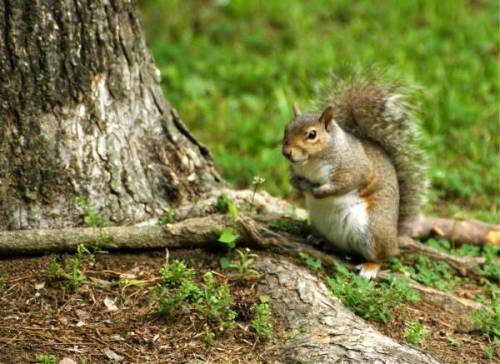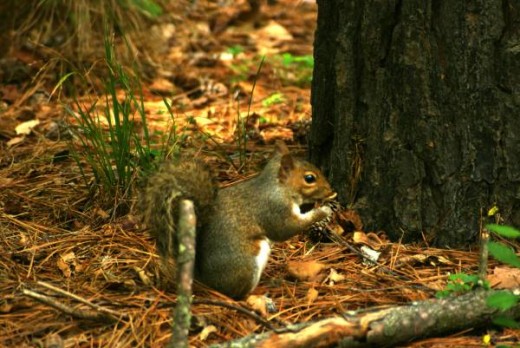North Carolinas State Mammal: The Grey Squirrel
North Carolina's State Mammal

Call it a tree rat with a bushy tail if you will, the gray squirrel is North Carolina’s state mammal. There are six other species of squirrels in the state, but the gray is the most common. Gray squirrels are at home in the country and the city.
Early colonists to the Carolinas found the gray squirrel abundant and a valuable source of food. Some historians credit the excellent marksmanship the colonists achieved in squirrel hunting carried over to their ability to win in battle against the British — giving the lowly gray squirrel credit for winning our independence.
Squirrels are still hunted for food and sport. Some people consider squirrels a nuisance. They are very adaptive to human beings and often choose buildings for nesting locations, causing a fire hazard when they bring in nesting material or chew on wiring. They can fall down a chimney or inside walls and become trapped and die, causing a biohazard. Squirrels are blamed for raiding gardens and bird feeders. Sometimes it takes a professional wildlife removal service to solve a squirrel invasion problem.
On the other hand, squirrels provide a connection to nature through observation and cohabitation. Many people enjoy feeding and watching squirrels, whether on their own property or in public parks. It is fairly easy to tame a wild squirrel to the point it will take food from your hand. Realize there is always the risk of being bitten or starched and it is best to let the wild be wild. Feed from a feeder or a distance.
Squirrel Noise
Squirrels do not present many health problems to humans. They are not common carriers of rabies since they seldom come in contact with rabid animals, but that is not to say they can’t have rabies. They do have fleas, ticks and other parasites that may present sickness as they do from any host animal.
The gray squirrel is named for its color, which can have some reddish highlights. The underbelly is white. The characteristic that most sets them apart from their ratty cousin in the rodent family is their bushy tails. The average size is about eighteen inches from nose to tail tip and they weight in at about eighteen ounces.
Clucks, chatter, and squealing make up the squirrel’s vocabulary. They are most vocal when alarmed. Squirrels are excellent tree climbers and quite the acrobatic performers. They jump from limb to limb and tree to tree with the greatest of ease. They do fall once in a while, but usually not worse for the experience.
Gray Squirrel Eating Pine Cone

The most important part of their diet is the nuts of hardwood trees. Fruits, cones, seeds, bark, roots, mushrooms, fruits and berries and even flowers and flower buds make up the rest of their diet. Their front paws are well suited for grasping and holding onto food. They are known to store food for winter by hiding it or burying it. The law of averages rather than memory accounts for them finding what they hid.
Water, an essential element to squirrel survival, can be satisfied with succulent plants and even dew so they do not have to live close to open water.
Their territory ranges from one and a half to eight acres, depending on density of population and dominance. They make large nest high in trees from sticks and leaves. They normally breed twice a year, in fall and spring. A litter is one to six babies weighing about two ounces each. Most squirrels do not survive their first year. The average life expectancy for those surviving their first year is one to two years, but some have been known to live seven or eight years in the wild. External and internal parasites and predators account for their low mortality rate.
Rep. Basil Barr of Ashe County introduced the bill to name the gray squirrel as the official state mammal in 1969. He characterized the squirrel as courageous and thrifty, but it actually the gray squirrel was chosen by the State’s school children through a sate-wide survey Barr conducted.








